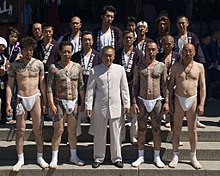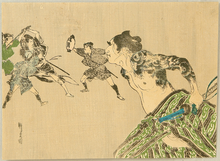Yakuza
Yakuza ヤクザ is the name applied in Japan to both organized crime organizations and their members. A Japanese equivalent to the mafia dating back to the 17th century. The modern yakuza has extended its activities to bank and political corruption. In 2009, the latest year on record, it had an estimated 87,900 members in Japan.
Etymology of the name
The origin of the word yakuza is unknown, but it is widely believed that it comes from the lifestyle of the bakuto (博徒 'gamblers'), one of the the two social classes that gave rise to the yakuza (the others being the tekiya or "peddlers"). The bakuto were very low in the Japanese society of the Edo period, because gambling was prohibited. From this he derived his undesirable image and the name ya (eight), ku (nine) and za (three), since 8, 9 and 3 is 20 points, the worst hand in oicho-kabu, a variant of the hanafuda card game.
History
During the Edo period, the figure of the samurai was privileged within society due to their military efficiency and the security services they provided to the community, through the daimyō, feudal lords or the shogun. At the end of the period of wars, Japan enters its modern era and continues to unify into a single government, so many samurai were dismissed because they were useless to the new destinies of the nation and became itinerant mercenaries known as rōnin. They continued to do jobs independently for their bosses and high society. Over time, they began to organize themselves into paramilitary bands that protected regions in exchange for food and comforts provided by the community. A short time later they end up dominating the illegal businesses of Japan.
At the end of the 19th century and at the beginning of the 20th they had control over gambling, smuggling, money laundering, entertainment, real estate speculation, extortion, drug and arms trafficking. In addition, after World War II, certain gangs of far-right ideology began to operate and extort money within political groups.
Their organization was derived from the samurai codes but much more structured and strengthened; The entire clan considers itself a family where absolute fidelity to the band, ultranationalism, obedience to the highest rank and its strict and brutal code of honor are professed. Newbies are indoctrinated through the senpai-kōhai system, which specifies the procedures for punishing disloyalty, such as the amputation of a little finger for a member who commits a serious mistake or commits treason. Said amputation is still used today to recognize retired or dissident members. The amputation was carried out mainly on the little finger of the left hand, since it is the finger that applies the most force when making a cut with the katana, by losing that finger you could not be deadly in combat with katanas, you would become useless and you ended up demoted or kicked out of the organization.
Tattoos within the organization are very important; they often reveal the rank within the organization, the clan to which one belongs, the clan motto, some include dragons and references to their samurai genealogy. Most start out as a huge tattoo with additions removed and end up covering small parts of the body; The tattoo is one of the most characteristic physical features of the yakuza. Such tattoos are applied with the tebori technique, which is very painful, and the time it takes to finish the tattoo can be months or even years; It is not tattooed with a single needle but with several. The yakuza wear these tattoos to prove their identity, although the tattoos can be grounds for refusal of entry into public baths.
Featured Yakuza Clans
The following are the most important yakuza clans:
| Name of the organization | Description |
|---|---|
| Yamaguchi-gumi | The Yamaguchi-gumi is a crime union based in Kobe, Hyogo Prefecture, and is the largest designated crime union in Japan. The membership is approximately 8,900 (about 4,100 members and some 4,800 associate members). It has subsidiaries in 43 prefectures, except in Yamagata, Hiroshima, Kagoshima and Okinawa (as of December 2019). Along with the Sumiyoshi-kai, the Kobe Yamaguchi-gumi and the Inagawa-kai, is one of Japan's leading bands. |
| Sumiyoshi-kai (Sumikikai) | Sumiyoshi-kai is an organized crime union based in Akasaka, Minato-ku, Tokyo. It is recognized by the U.S. government as an international criminal organization involved in drug and arms smuggling, human trafficking and other crimes. In December 2019, it has approximately 2,800 members in 15 prefectures in Tokyo, 1 province and 1 prefecture, and approximately 4,500 members, including associate members. Along with the Yamaguchi-gumi VI, the Kobe Yamaguchi-gumi and the Inagawa-kai, it is considered an important band. |
| Kobe Yamaguchi-gumi | The Kobe Yamaguchi-gumi (Kobe Yamaguchigumi) is a designated crime union with its main office (sede) located at 3-10-7 Ninomiya-cho, Chuo-ku, Kobe city, Hyogo prefecture. At the end of December 2019, it had some 3,000 members (approximately 1,500 members and some 1,600 associate members). Along with the Yamaguchi-gumi, the Sumiyoshi-kai and the Inagawa-kai, it is considered an important band. |
| Inagawa-kai | The Inagawa-kai is a Japanese professional band based in Roppongi, Minato-ku, Tokyo. As at 31 December 2019, it had approximately 3,400 members (approximately 2,100 members and approximately 1,300 associate members). |
| Kudo Club | The Kudo-kai is a gang based in the city of Kitakyushu, prefecture of Fukuoka, Japan, with approximately 580 members in December 2019 (280 members and 300 associate members). Its main areas of activity are the prefectures of Fukuoka, Yamaguchi and Nagasaki, as well as the Tokyo metropolitan area. It is the largest band organization in the Kitakyushu area and the largest in the Kyushu region. |
Contenido relacionado
Celtiberians
Bering strait
St. Petersburg


